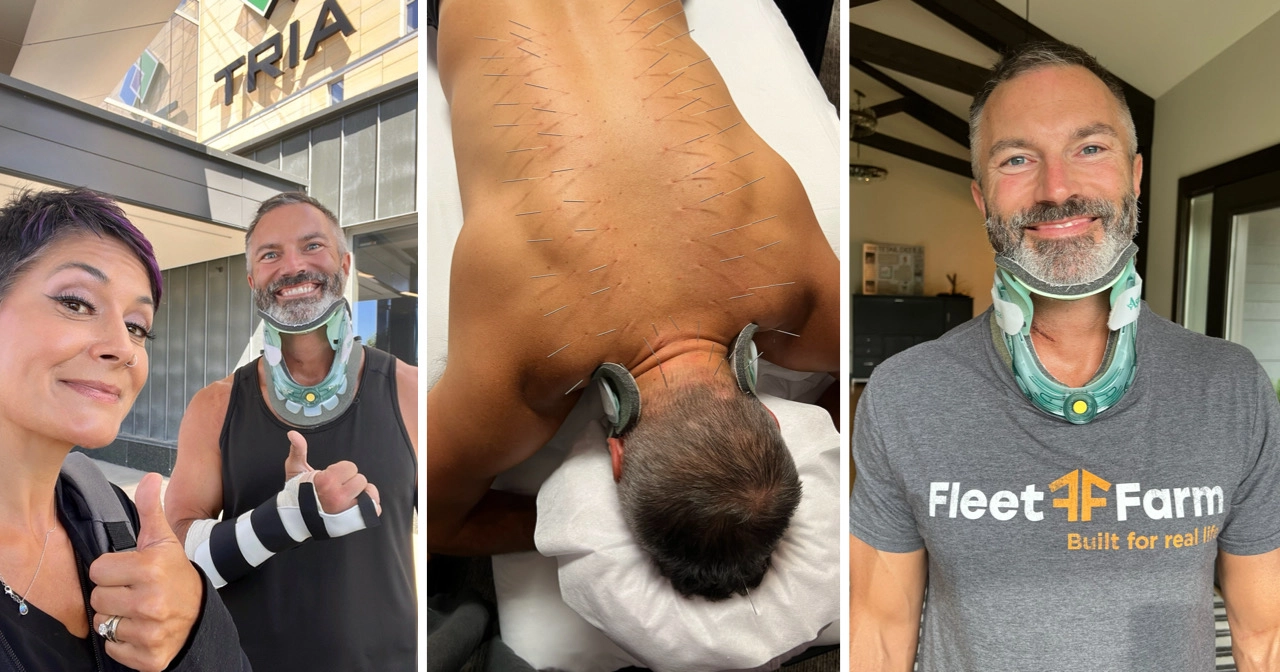Listen on: Apple Podcasts | Spotify
“How’s your recovery going?” I get this question a lot, and it’s kind of a loaded question. In the second or two I take to respond (or more if if someone asks through a text message), I quickly ask myself a few questions: Are they sincerely interested or just being polite? Do they want to hear the whole answer or just the highlights? If I share the whole answer, will it make me feel better or worse after sharing.
That might seem silly, but I understand the importance of maintaining the right mental attitude. It’s just as important, if not more important, than the supplements I’m using, therapies I’m getting, the diet I’m eating, or the workout program I’m following.
That’s why I’m dedicating a whole blog post to playing the mental game of injury rehab and recovery.
I thought it might be helpful to outline the guidelines I’ve established to make sure I avoid developing a pessimistic, doubtful, lazy, complacent, or victimhood mindset.
Not surprisingly, these guidelines have a place in other pursuit’s beyond a swift and complete recovery from injuries and ailments.
Oh, and if you haven’t already, be sure to read my first two blog posts about my broken neck and spinal cord injury:
- I Broke My Neck, Part 1: Injuries, Surgery, and Recovery Challenges
- I Broke My Neck Part 2: What I’m Doing to Recover And Why
You can also find numerous updates of the day-to-day recovery process on my Facebook timeline, starting on July 30, 2022.
I will never seek or accept sympathy.
This is more of a rule than a guideline for me, and it’s a rule I’ve tried to live by for years, not just after going head first over my handlebars on my mountain bike.
Sympathy is defined as a feeling of pity or sorrow for the distress of another; commiseration.
Getting sympathy from others does nothing to keep me focused on the tough, uncomfortable, sometimes painful process of rehabbing my nervous, muscular, and skeletal systems.
Instead, getting sympathy leads to self-pity.
If someone else pities me or feels sorrow for my current state of being, I will undoubtedly feel pity or sorrow for myself. That won’t help me remain optimistic. It’ll do the opposite. It’ll lead me to look at the world through the eyes of a pessimistic victim.
That’s bad for me but also bad for the person I’m interacting with.
Why would I want to infect his or her mind with pity or sorrow? If I’m not dead, God’s not through with me yet.
You can’t be a light for others, much less yourself, when you’re consumed by the darkness of self-pity, pessimism, or victimhood.
Of course, people may express sympathy, especially those who care most. You just have to do your best to ignore it.
I must surround myself with encouragers, not doubters or downers
If you’ve followed the posts and stories Vanessa has shared over the past five weeks, you know I dismiss those who doubt my abilities, or those who think they know my body better than I do.
That started the morning after my surgery when I was supposed to stay in bed for a few days. I wanted to stand even though the nurses said I shouldn’t. I knew that I could. They doubted me. To emphasize my point, I stood on each leg, one at a time, and balanced, and then did a half squat on each leg.
Early on in my recovery, it was easy to keep doing what I knew I needed to, despite having people tell me I shouldn’t or couldn’t.
But the ability to ignore critics, doubters, or downers only lasts so long.
It’s part of why I wanted to get out of the hospital immediately. I didn’t want doctors and nurses telling me what I was capable of based on their standard of care documents.
I’ve also been cautious about interacting with others who would tell me to slow down, follow the doctor’s guidelines, or spend more time resting. Surrounding myself with such people could lead me to trust their “advice” instead of listening to my intuition.
I’d still be lifting soup cans and limiting my squats to the toilet or the couch.
Instead, with Vanessa by my side at the gym, I’ve regained about 40% of my strength in five weeks.
That wouldn’t have happened if I’d gone along with the “take it easy” advice and accepted the idea that it would take 12-18 months to recover, after which I’d only regain 50-85% of my original strength and function.
I plan to walk into my 12-week follow-up with my surgeon without needing my neck brace and with most function restored. I also plan to be skiing by the end of December, five months after the accident.
Again, the Downers and Doubters would say that’s too soon. Too risky. Too dangerous.
Is it possible I won’t be ready? It’s possible.
But I plan to do everything I can to be recovered in five months and enjoy life from that time on, rather than missing out on what we love to do while waiting another 7-13 months because someone else told me it would take that long.
I will do the work, no matter my mood or motivation.
Lately, I haven’t felt inspired to exercise. But most days, I didn’t feel motivated to work out before the accident either.
Unfortunately, most people have been sold the idea that they need the motivation fairy to sprinkle them with motivation dust so they get themselves to the gym and work out.
Some types of exercise are fun. As an example, I love to mountain bike. But mountain biking isn’t a workout. It’s recreation.
Muscle and bone-building, mobility-developing, stamina-inducing, fortitude-forming strength training is exercise. It’s the most important form of exercise for health, longevity, and fitness.
It can be fun. But it doesn’t need to be enjoyable. You just have to do it. You have to do the work. Consistently.
The same could be said of the other things I’m doing to speed up recovery. Most aren’t fun or exciting. But they need to get done if I’m going to enjoy the benefits of the body God has still blessed me with.
I shared the following in my Nikkola Newsletter, but in case you skipped over it or missed it, I thought it was worthwhile to share it again.
He said that a gym was a 30-minute drive, and he probably wouldn’t stick with his program if he needed to do that. So, he built a gym in his barn, including a pulley system.
When he talked about pull-ups, he said he couldn’t even hang from his bar when he started. Now, he can hang for at least 5 seconds. I asked him if he wanted me to recommend some alternative exercises, to which he replied, “no.” He wants to keep working toward doing the movements as prescribed.
When I posted a challenge workout with 100 pushups, he got them all done as knee pushups, broken up over the course of his day. Regarding his diet, he’s eating more protein than he has in his life, and though he’s only lost six pounds, he’s down two belt loops.
This is just a portion of what I listened to during a recent nutrition & lifestyle coaching session. It was filled with optimism, determination, and personal responsibility. Oh, and one more thing…this gentleman is 72 years young.
After our call, I told Vanessa that I wished he was a neighbor. I’d love to sit in his barn for a whole day and listen to him talk about so much more than his fitness program.
I wish his determination and commitment were common, but it’s not. Instead, we’re encouraged to avoid discomfort, get coddled when we don’t take care of ourselves, and just fit in with the “norm” when we get weak, overweight, and develop preventable disease.
It doesn’t matter what age you are or what excuses you’ve come up with to justify not strength training. It’s a necessity for optimal health and longevity.
I will share the whole truth with no more than two encouraging friends and my spouse
I already mentioned why sharing the crappy parts of recovery with everyone isn’t a good idea. But I, and you, do need to share it with a few people. The key is that they won’t pity you for your problems.
I’ve share the unfiltered version of the answer to the question, “How’s your recovery going?” with two friends and that’s it. Neither pities me when I talk about moments of depression, fatigue, or how I feel like crap for putting Vanessa in a position to care for me, they just listen, show a little empathy, and then gently kick my mindset back into optimism.
I can retell how I’m feeling with a couple of people and not have my rehearsal affect my mood and outlook. Retelling it to everyone who asks would be devastating, as each time I’d retell the negative stories, I’d put myself in that disempowering state of mind.
The same goes for Vanessa. She keeps me moving forward because she wouldn’t tolerate me wallowing in self-pity. Then again, we probably wouldn’t be with each other if we were the types who sought sympathy for life’s bumps and bruises.
I will set an example that inspires, not one that looks like the “average”
Bahram Akradi is the founder and CEO of Life Time, the top health and wellness company in North America. The fitness facilities he and his company have built are unmatched.
I worked for Life Time for almost 15 years, half of which was at the corporate office.
Bahram often visited different divisions in the company, so it wasn’t unusual for him to walk past my cube or office during my time there.
As a result, I often guided my work by the possibility he’d see what I was doing. So, I’d ask myself, “What would Bahram think about what I’m doing right now?” After all, it was ultimately he who was paying my generous salary to make difference for the company.
Vanessa and I work for ourselves today, but I still use a similar line of thinking to guide me day-to-day. “What would my clients, blog readers, and social media followers think about what I’m doing right now? Would it be consistent with what I teach and preach?” In essence, am I walking my talk?
What if someone dropped in unannounced, and saw the way I was living when I’m not online? Would it align with what they believe about me based on what I said?
I suppose that walking my talk is a form of integrity. I feel a sense of responsibility to do what I ask of others because my advice is always intended to make people stronger, healthier, and fitter.
That’s why I went back to the gym five days after my surgery.
Or, two days after my bicep reattachment eight years ago.
I have always believed that exercise is one of the most powerful tools for helping a body recover from injuries, even if you’re not exercising that specific body part.
I also talk about the health benefits of a high-protein diet constantly. Had I not started eating high-protein meals the day after surgery, there would’ve been a mismatch between what I say a high-protein diet can do and my choice of whether or not to follow that advice myself. And everything else about this recovery process.
Our chiropractor said that some things in life don’t happen for your own benefit but so that you can use them to teach and inspire others. I believe that’s what this is all about for me. Not that I chose to end up in this predicament, although I did choose to ride on the bridge where I crashed and ended up here. But ever since the first day after the surgery Vanessa and I have both believed we could do something good with this.
I understand that some people have diseases, disabilities, and injuries that they cannot come back from. But most people can do more with what they have than what they do today. And many people can do much more with the bodies they’ve got than what they’re doing today.
We can all set examples for others of what’s possible with these bodies God has blessed us with. If all of us did, fewer people would feel it’s okay to live with complacency in bodies that are operating a fraction of what they could be.
I’ll set an example. I hope you will too.



